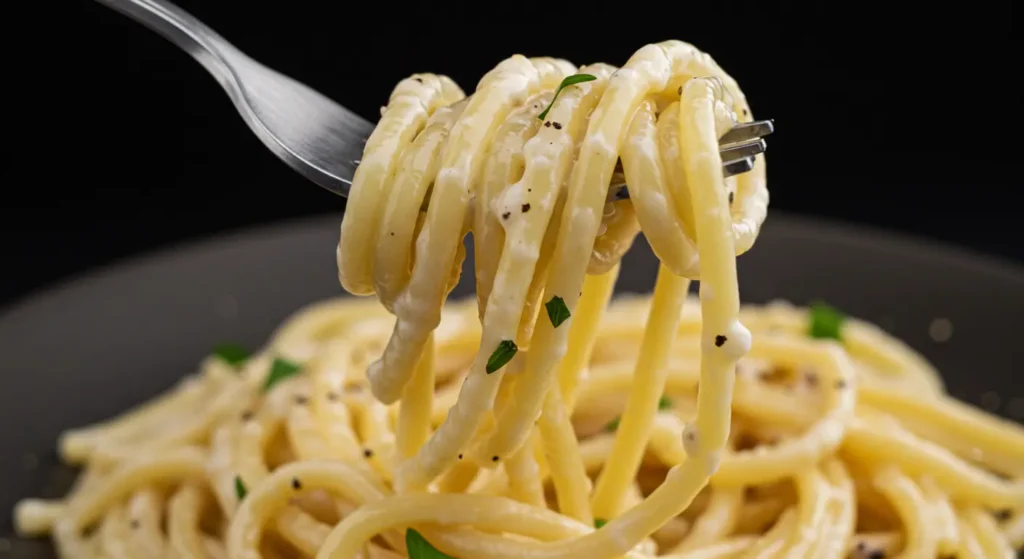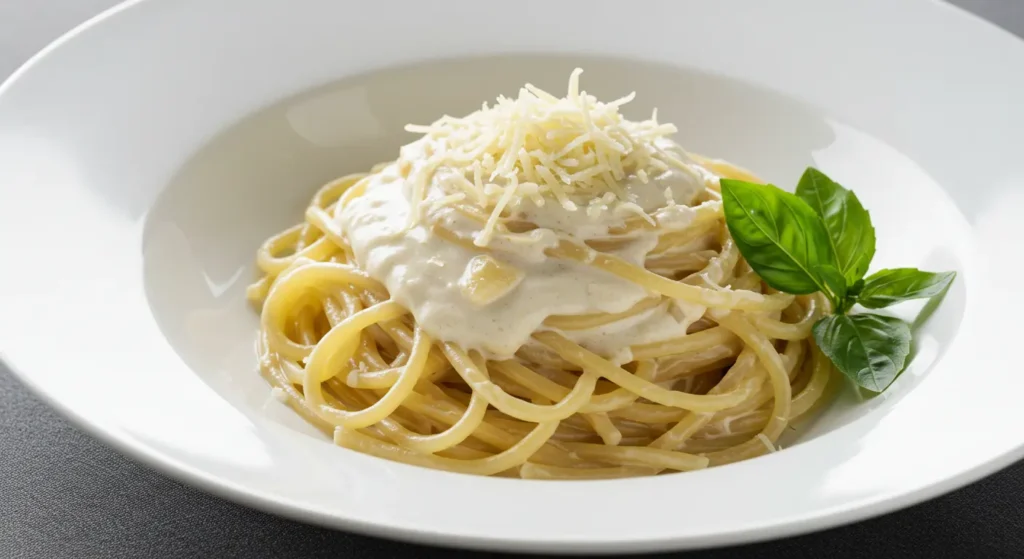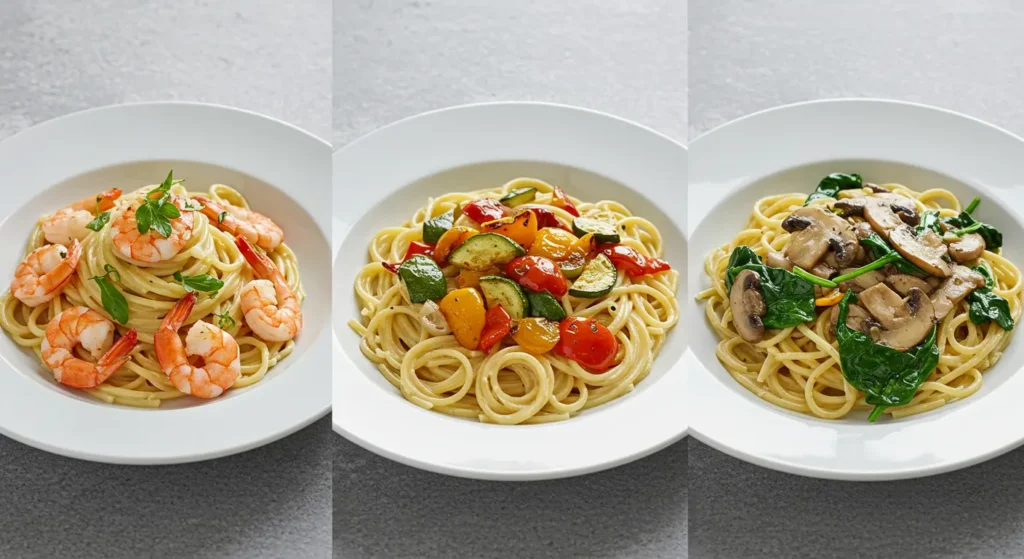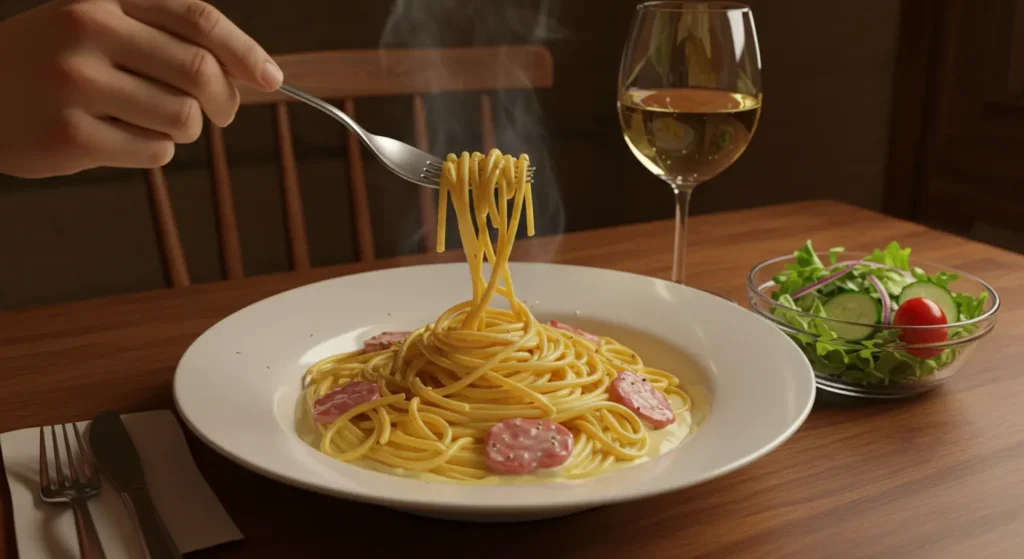Creamy Spaghetti – Why This Recipe?
As Chef Greeny, I still remember the first time I discovered the magic of a truly exceptional creamy spaghetti. It was during a particularly cold winter evening when comfort food wasn’t just desired—it was necessary. After experimenting with countless pasta dishes over my 15-year culinary journey, I’ve found that creamy spaghetti holds a special place in both my professional kitchen and my home.
What makes this particular creamy spaghetti recipe worth your time? It combines the perfect balance of rich, velvety sauce with al dente pasta, creating a harmonious dish that satisfies both sophisticated palates and picky eaters alike. Unlike many cream-based pasta recipes that can feel overwhelmingly heavy, my version incorporates brightening elements that keep you coming back for more without weighing you down.
The recipe I’m sharing today has been perfected through years of testing and refinement. I’ve added my signature twist by incorporating a blend of three cheeses and a hint of lemon zest—an unexpected combination that elevates this dish from everyday pasta to something truly memorable.
By the end of this post, you’ll learn not just how to make an exceptional creamy spaghetti, but also understand the techniques that make Italian pasta dishes sing, how to create the perfect sauce consistency, and ways to customize this versatile recipe for any dietary need or occasion.
Creamy Spaghetti – Ingredients and Preparation
Ingredients List
For the pasta:
- 1 pound (16 oz) dried spaghetti
- 2 tablespoons kosher salt (for pasta water)
For the creamy sauce:
- 2 tablespoons olive oil
- 3 tablespoons unsalted butter
- 4 cloves garlic, minced
- 1 small shallot, finely diced
- 2 cups heavy cream
- 1 cup freshly grated Parmesan cheese
- ½ cup freshly grated Pecorino Romano cheese
- ¼ cup mascarpone cheese
- ½ teaspoon freshly ground black pepper
- ¼ teaspoon freshly grated nutmeg
- 1 teaspoon lemon zest
- ¼ cup reserved pasta water
For garnish:
- Fresh basil leaves, torn
- Extra Parmesan for serving
- Red pepper flakes (optional)
Substitution options:
- Gluten-free: Use gluten-free spaghetti made from rice, corn, or chickpea flour
- Dairy-free/Vegan: Replace heavy cream with full-fat coconut cream, use dairy-free butter, and substitute vegan cheese alternatives for the Parmesan, Pecorino, and mascarpone
- Lighter option: Substitute half the heavy cream with chicken or vegetable broth, use light cream cheese instead of mascarpone
Step-by-Step Instructions
- Prepare your workspace. Measure all ingredients and have them ready before beginning. This “mise en place” approach ensures smooth cooking, especially important for creamy spaghetti where timing is crucial.
- Bring a large pot of water to a rolling boil. Add 2 tablespoons of kosher salt to the water. The water should taste salty like the sea—this is essential for properly seasoned pasta.
- Cook the spaghetti. Add pasta to the boiling water and cook for 1-2 minutes less than the package instructions. You want it firmly al dente as it will continue cooking slightly in the sauce. Set a timer to avoid overcooking. Chef’s tip: Stir the pasta within the first 30 seconds of adding it to the water to prevent sticking.
- Begin the sauce while pasta cooks. In a large, deep skillet or sauté pan, heat olive oil and butter over medium heat until the butter is melted and begins to foam slightly.
- Sauté aromatics. Add the minced garlic and diced shallot to the pan and cook until fragrant and translucent, about 2-3 minutes. Be careful not to brown the garlic as it will become bitter. Chef’s tip: If the garlic begins to color too quickly, reduce the heat immediately.
- Add the cream. Pour the heavy cream into the pan and bring to a gentle simmer. Reduce heat to medium-low and let it reduce slightly for about 5 minutes, stirring occasionally.
- Reserve pasta water before draining. Before draining the pasta, scoop out ¼ cup of the starchy pasta water and set aside.
- Drain the pasta. Quickly drain the pasta but do not rinse it—the starch on the surface helps the sauce adhere.
- Add cheeses to the sauce. Reduce heat to low and gradually add the grated Parmesan and Pecorino Romano to the cream, stirring continuously to create a smooth sauce. Once incorporated, add the mascarpone and stir until melted.
- Season the sauce. Add the black pepper, nutmeg, and lemon zest, stirring to combine. The lemon zest is subtle but crucial for balancing the richness of the cream.
- Combine pasta and sauce. Add the drained pasta directly to the sauce in the pan. Using tongs, gently toss the pasta to coat it evenly with the creamy sauce.
- Adjust consistency. If the sauce seems too thick, add a splash of the reserved pasta water to loosen it. The starch in the water helps emulsify the sauce, creating a silky texture that clings to the pasta.
- Final seasoning. Taste and adjust salt and pepper as needed. Remember that the Pecorino and Parmesan are already salty, so additional salt may not be necessary.
- Serve immediately. Transfer to warmed plates or a large serving bowl. Garnish with torn fresh basil leaves, additional grated Parmesan, and red pepper flakes if desired.
Notes and Tips
Storage tips:
- This creamy spaghetti is best enjoyed immediately after preparation when the sauce is at its perfect consistency.
- If you must store leftovers, refrigerate in an airtight container for up to 2 days.
- To reheat, place in a skillet over low heat and add a splash of milk or cream to revive the sauce as it tends to thicken when cold.
- This dish does not freeze well as the sauce will separate upon thawing.
Serving suggestions:
- Pair with a crisp green salad dressed with a light vinaigrette to balance the richness of the pasta.
- A glass of dry white wine such as Pinot Grigio or Sauvignon Blanc complements the creamy sauce perfectly.
- For a complete meal, serve with simply grilled chicken breast or sautéed shrimp.
Make-ahead instructions:
- If preparing for guests, you can cook the pasta ahead of time (keeping it very al dente), toss it with a touch of olive oil, and refrigerate.
- The sauce can be partially prepared in advance—sauté the aromatics and reduce the cream, then refrigerate.
- About 15 minutes before serving, reheat the sauce, add the cheeses, and proceed with the remaining steps.
Creamy Spaghetti – Nutritional Information
Nutrition Facts (Per Serving – Based on 4 servings)
- Calories: (~685)
- Carbohydrates: (65g)
- Protein: (18g)
- Total Fat: (42g)
- Saturated Fat: (25g)
- Unsaturated Fat: (14g)
- Trans Fat: (0g)
- Fiber: (3g)
- Sugar: (4g)
- Cholesterol: (125mg)
- Sodium: (650mg)
Note: Nutritional values are approximate and may vary based on specific ingredients and brands used.
Creamy Spaghetti – History and Cultural Significance
The creamy spaghetti as we know it today represents a fascinating fusion of traditional Italian pasta techniques with American adaptations. While classic Italian cuisine typically pairs specific pasta shapes with regional sauces—with many purists insisting that cream-based sauces belong primarily with certain pasta shapes like fettuccine—the versatility of spaghetti has made it a perfect canvas for creamy interpretations worldwide.
The roots of cream-based pasta sauces in Italian cuisine can be traced back to northern regions like Emilia-Romagna, where dairy production flourishes. The famous Alfredo sauce, which shares similarities with our creamy spaghetti sauce, was actually created in Rome in the early 20th century by Alfredo di Lelio. However, what Americans know as Alfredo sauce is considerably different from the original Italian version, which simply combined butter and Parmesan with the pasta’s starchy cooking water.
Interestingly, similar dishes appear across various cuisines. In Greek cuisine, you’ll find pasta dishes with mizithra cheese that create a creamy texture. Meanwhile, Japanese cuisine has adopted and transformed Italian pasta dishes, creating unique creamy spaghetti variations that often incorporate dashi or mentaiko (spicy cod roe).
The beauty of creamy spaghetti lies in its evolution as a comfort food that transcends cultural boundaries. It represents how culinary traditions travel and transform, adapting to local tastes while maintaining their essential character.
Creamy Spaghetti – Creative Variations
The Seafood Symphony
Transform your basic creamy spaghetti into an elegant seafood pasta by incorporating:
- 8 oz of mixed seafood (shrimp, scallops, or crab meat)
- 1 tablespoon of finely chopped fresh dill
- A splash of dry white wine in the sauce
- Lemon wedges for serving
Simply sauté the seafood separately until just cooked, then fold into the finished pasta just before serving. The brightness of the dill and lemon perfectly balances the rich cream sauce while complementing the delicate seafood flavors.
The Plant-Based Perfection
This vegan variation doesn’t compromise on creaminess or flavor:
- Replace heavy cream with 1½ cups cashew cream (soaked raw cashews blended with water)
- Substitute the cheeses with ¼ cup nutritional yeast and 2 tablespoons white miso paste
- Add 1 cup of sautéed mushrooms (cremini or shiitake) for umami depth
- Include 1 cup of wilted spinach for color and nutrition
- Enhance with 1 teaspoon of truffle oil (optional but highly recommended)
The combination of cashew cream and nutritional yeast creates a remarkably cheesy flavor profile, while the mushrooms provide a satisfying texture and depth that complements the creamy sauce beautifully.
The Protein-Packed Primavera
For those looking to create a more balanced, colorful meal:
- Add 1½ cups mixed roasted vegetables (bell peppers, zucchini, cherry tomatoes)
- Include 2 cups fresh baby spinach, folded in just before serving to wilt
- Mix in 1 cup shredded rotisserie chicken or sliced grilled chicken breast
- Enhance with 2 tablespoons fresh herbs (basil, parsley, and chives)
- Add ½ teaspoon smoked paprika for a subtle depth
This variation transforms the dish into a complete meal with protein and vegetables while maintaining the comforting creamy texture that makes the original so appealing.
Creamy Spaghetti – Frequently Asked Questions
Can I make creamy spaghetti ahead of time?
While creamy spaghetti is best enjoyed fresh, you can prepare elements ahead. Cook the pasta al dente, toss with a little olive oil, and refrigerate separately from the sauce. Make the sauce up to the point of adding cheese, then refrigerate. When ready to serve, reheat the sauce gently, add the cheeses, then combine with reheated pasta and a splash of cream or pasta water to refresh the consistency.
What can I substitute for heavy cream to make this lighter?
For a lighter version, substitute half the heavy cream with chicken or vegetable broth. Another option is using half-and-half or whole milk thickened with a tablespoon of cornstarch (mixed into the cold dairy before adding to the pan). While these substitutions will reduce calories and fat, they will produce a slightly less rich sauce.
How do I prevent my creamy sauce from separating or curdling?
To prevent separation:
- Use room temperature cheese rather than cold
- Remove the pan from heat before adding cheese
- Add cheese gradually while stirring constantly
- Never let the sauce boil after adding cheese
- Ensure your cream has a high enough fat content (heavy cream works best)
How long does it take to prepare creamy spaghetti from start to finish?
The complete preparation time is approximately 30 minutes: 15 minutes for preparation and 15 minutes for cooking. This makes it an ideal weeknight dinner option that feels special enough for weekend entertaining.
Can I add protein to this dish?
Absolutely! This creamy spaghetti provides an excellent base for adding proteins. Grilled chicken breast, sautéed shrimp, or even sliced Italian sausage integrate beautifully. For vegetarians, roasted chickpeas or white beans add protein while complementing the creamy texture.
Creamy Spaghetti – Final Thoughts
The beauty of creamy spaghetti lies not just in its rich, velvety sauce or perfectly cooked pasta, but in its ability to transform ordinary ingredients into something truly extraordinary. This dish represents what I believe cooking is all about: creating moments of joy around the table, turning simple meals into memorable experiences.
Whether you’re preparing this creamy spaghetti for a quiet dinner at home or hosting friends for a special occasion, the fundamental techniques and flavor principles remain the same. Focus on quality ingredients, respect the cooking process, and don’t be afraid to make the recipe your own.
I encourage you to experiment with the variations I’ve suggested or create your own unique twist. Perhaps add your favorite seasonal vegetables, experiment with different cheese combinations, or incorporate a protein that makes the dish uniquely yours.
Remember that pasta, especially creamy spaghetti, continues to absorb sauce as it sits, so serving immediately yields the best texture and flavor balance. And don’t forget that final grating of fresh Parmesan and crack of black pepper—these small touches make all the difference.
I’d love to hear about your experiences with this recipe! What variations did you try? Did the preparation techniques work well for your kitchen setup? Your feedback helps our culinary community grow and improve together.
For more information about the historical development of pasta dishes across cultures, you might find this Wikipedia article on pasta fascinating.
Until next time, may your pasta always be perfectly al dente and your sauce sublimely creamy!
Chef Greeny







